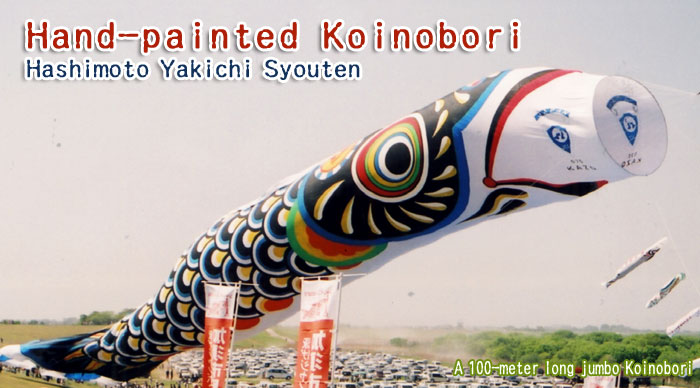 |
||
| Koinobori, Koi-shaped streamers, decorate the landscape everywhere in Japan from the middle of April through early May, in honor of Children's Day on May 5. Derived from the Toryumon Legend **1, the Koi symbolizes courage and strength in Japan and families traditionally flew Koinobori in front yards of homes to honor their children wishing for their health and success.
Kazo City, Saitama Prefecture is known as the leading producing district of Koinobori. Hashimoto Yakichi Syouten was founded by the grandfather of the current representative and is one of the nation's few manufacturers and the only one in town of hand-painted Koinobori. |
||
| Why Kazo City became the leading producing district of Koinobori? | ||
| Mr. Takashi Hashimoto The tradition of Kazo’s Koinobori industry began when paper lantern and umbrella artisans of the Meiji Era started to make Koinobori as a second business. The store became to be referred to as “kiwamonoya”, a store that mainly deals with seasonal articles such as dolls for Girls’ Festival. In the 12th year of Taisho (1923), many of the kiwamonoyas in the Tokyo area were destroyed by The Great Kanto Earthquake. The wholesalers of Asakusabashi (one of Tokyo’s districts where many seasonal articles are made) had no choice but to purchase from kiwamonoyas in Kazo City, which was when the reputation of “Kazo’s high quality Koinobori” started to spread out. Kazo’s kiwamonoyas started receiving a rush of orders and ended up specializing in Koinobori. At the time, 40 kiwamonoyas stood side by side in Kazo City, and all of the stores hand-painted Koinobori, including ourselves. The city was literally “a Koinobori town” because Koinobori were hung outside to dry be summer or winter. In the 8th year of Showa (1933) when the present Emperor Akihito was born, my grandfather Yakichi presented our Koinobori to the Imperial family. |
||
| When did the other 40 kiwamonoyas stop hand-painting? | ||
Perhaps in the year of the Tokyo Olympics (the 39th year of Showa, 1964). The “printing on nylon fabric” method, which was developed after the war, became more popular. You can mass produce using this method; many people were attracted to the advertising slogans and were buying them even though the “new material” was expensive. Compared to that, silk cotton was a fabric used daily and was not a novelty anymore like nylon. When we delivered hand-painted Koinobori to the wholesalers, there were times we received complaints like “why did you have to bring in more hand-painted ones when I just finished selling them!” |
||
| Why did you stick to hand-painting when everybody else started the “print” style? | ||
| Mr. Takashi Hashimoto The truth is that we also thought about changing over to printing because hand-painting wasn’t enough to do business. We called the pattern maker to have the patterns of our hand-painted Koinobori traced. But he told us he couldn’t do it. We asked him the reason and he told us that “this design is not suited for printing, so you would have to make a new design.” So we tried to make designs just for printing, but the patterns we made using compasses and rulers turned out to be uninteresting like drawings in coloring books. But of course we needed to make a decent living, so we had a family discussion: “Let’s forget hand-painting after creating the best hand-painted Koinobori ever, one that can be even put up in a museum.” Just about the same time, a young newspaper reporter came to interview us about hand-painted Koinobori. After the article was published, we received calls from people “wanting to fly hand-painted Koinobori.” Since we were about to stop producing hand-painted Koinobori and had few on stock, we had a really hard time. When we told our last client of that year that we had sold everything out, they got angry and told us “to produce more!” After that experience, we were afraid to say to our clients that we had none left, so we decided to keep producing them. So the real reason for continuing our hand-painted Koinobori is that we simply couldn’t make printed ones! The printing method of course allows mass production, but the finished products are all the same. But hand-printed ones are different. Every product that is hand-made evolves and has its own characteristics. This is a taste that can be only brought out by hand-paint, not by machine. |
||
|
|
||
| When deciding the designs of Koinobori, do you draw upon the patterns of Nishikigoi? | ||
| Mr. Takashi Hashimoto Koinobori is a “Koi that is about to turn into a dragon” as in the Toryumon Legend**1, so it is difficult to recapture a real Koi or Nishikigoi, but yes I do draw upon them. Unfortunately we don’t raise Nishikigoi, but I myself very much like to watch Koi, so I admire them at a park while traveling or at Saitama Prefecture’s Fisheries Experiment Station (Fisheries Experiment Station, Saitama Prefectural Agriculture and Forestry Research Center. Once developed long-finned Koi). Their leisurely swim and beautiful patterns inspire me; I would like to make Koinobori that beautiful some day. As a matter of fact, Koi’s figure is optimum for Koinobori. How the Koinobori fly depends on the diameters of their mouth, stomach, and tail. Koi is the most well-balanced of all fish. Every May, I plan a “Jumbo Koinobori” that measures up to 110m. A Koinobori of this size weighs approximately 650kg. However, one this big and heavy flies in wind of only 3 mps (velocity in which branches of the trees shake) and in ideal wind of 5~7 mps (velocity in which dust rise), which are not necessarily strong. I believe this can be achieved only with the figure of Koi. |
||
| Do you have clients from overseas? | ||
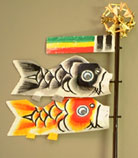 Mr. Takashi Hashimoto Mr. Takashi HashimotoYes, I do. Most of the people from foreign countries have never seen Koinobori, so they are fascinated with our work area and finished product. Some people buy them for souvenirs. Some fly them as we do in Japan, and others use them as room decorations. One way or another, since the background of Koinobori is of good omen, everybody is happy with them. |
||
| Nishikigoi are popular internationally, and the English notation for them is “Koi” and “Nishikigoi”. | ||
| Mr. Takashi Hashimoto Really? Well, that’s wonderful! I think it’s great that a word that describes the Japanese culture is incorporated in foreign languages as it is. The other day, a foreign tourist looking at the Koinobori asked the interpreter what it was, and the interpreter answered that it was a “Carp Flag.” But Koinobori is a Koi-shaped streamer, not a flag, so I really wanted the interpreter to have conveyed the Japanese word “Koinobori” to the tourist. |
||
| INPC will be introducing the Japanese culture to the world with a central focus on Nishikigoi, or them being the entrance to the Japanese culture. Since both Nishikigoi and Koinobori are Japanese culture, we believe it’s not necessary to make an English word out of them. We will note it as is. | ||
|
Mr. Takashi Hashimoto
|
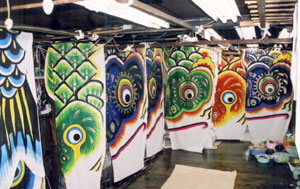
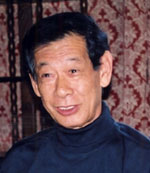
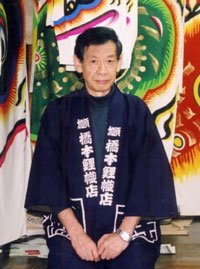 The 3rd generation of Hashimoto Yakichi Syouten, a store dealing with seasonal articles that has been in business for a hundred years from the Meiji Era (1868-1912)
The 3rd generation of Hashimoto Yakichi Syouten, a store dealing with seasonal articles that has been in business for a hundred years from the Meiji Era (1868-1912)